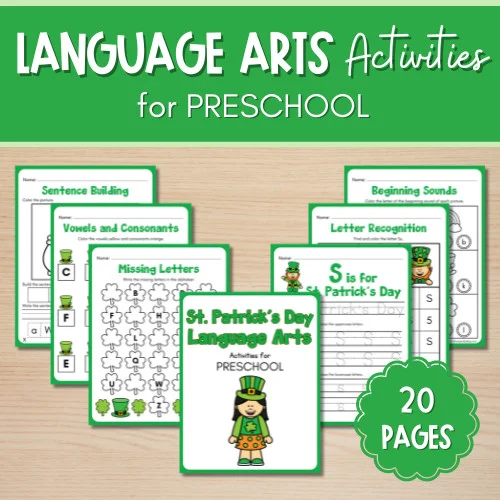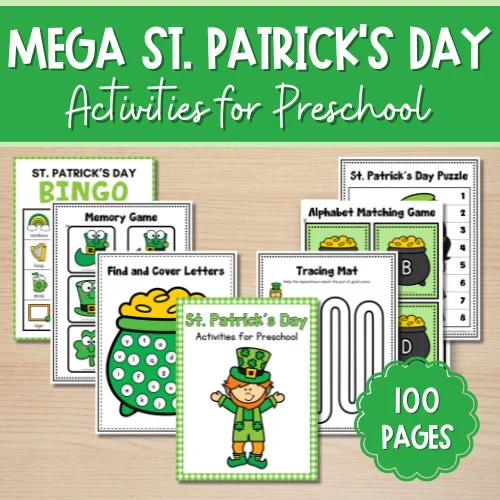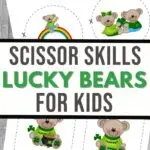You’ll love this Saint Paddy’s Day Bears Cutting Practice! It’s a fun and festive activity to excite the kids about St. Patrick’s Day! Plus – the bears and shamrocks are just the cutest!
Using this cutting printable to work on hand-eye coordination is a great learning tool. You can also talk about the upcoming festivities for the holiday as a fun and simple way to work on communication skills.

I love themed printables like this because the kids love doing them! Not only does this teach them independence in holding scissors, but it also helps them follow directions with minimal guidance.
What is the learning benefit of this printable?
When you’re trying to teach little learns how to cut and hold scissors, it can feel like a super hard task. These printables slow it down into easy-to-learn and do actions, giving them confidence.
They can follow lines in various circles and sections, using their scissors to cut along the way.
You can also use these free bear printables for little ones to trace. You could have them trace the lines first and then follow up with cutting the lines using scissors.
What it includes:
With the click of the print button, you’ll have multiple pages of learning fun at your fingertips. It’s a simple and easy way to

Fun ways to use this printable:
There are so many other ways to branch off from this scissor-skills printable and do learning fun!
Here are a few other ideas and options that anyone can do.
Draw four leaf clovers
Teaching children to draw four-leaf clovers can be a fun and engaging activity that fosters creative development. The four-leaf clover symbolizes good luck and is often associated with St. Patrick’s Day.
You can start by having the children draw a stem at the bottom of the page. Next, outline a three-leaf clover at the top of the stem. The children can then add the fourth leaf by drawing a small triangle shape off to the side of the clover.
Encourage the children to draw unique designs on each leaf, such as dots or swirls. This activity can also be used to teach children about the importance of symmetry and spatial relationships.
By teaching them to draw four-leaf clovers, you are providing a fun activity and fostering valuable skills they can use throughout their lives.
Find lucky things around the house with kids
The concept of luck has been fascinating for centuries, with different cultures and beliefs attributing different items or practices as lucky. It can be fun and educational to explore these beliefs with children, and one way to do so is to search for lucky things around the house together.
Depending on cultural backgrounds, this could involve finding four-leaf clovers, hanging horseshoes, or displaying figurines of lucky animals.
Encouraging children to explore the origins and meanings behind these symbols can foster curiosity and critical thinking skills.
Whether one believes in lucky charms or not, searching for them can be a fun way to bond with children and instill a sense of wonder and excitement about the world around them.
Talk about how to find gold at the end of the rainbow
Exploring the whimsical world of myths and legends with children can be an enriching experience for both the little ones and adults.
One particularly intriguing subject often encountered in folklore is the search for the elusive pot of gold located at the end of a rainbow.
While logically impossible, as rainbows are optical illusions created by the refraction and reflection of light, this notion can be a delightful one to explore with children.
Encouraging their imagination and curiosity! From ancient Greece and Norse mythology to modern-day literature and pop culture, the idea of gold at the rainbow’s end can take on various meanings and twists.
Such conversations can also touch on hopes, dreams, and perseverance, as pursuing a pot of gold can be seen as a metaphor for life’s journey and the rewards obtained along the way.
Engaging in fun conversations with children about the end of the rainbow can be a delightful way to bond with them while fostering their creativity and critical thinking skills.

How do I help my child learn how to use scissors?
Developing fine motor skills is important to a child’s growth and development. These skills are essential for everyday living and learning, from holding a pencil to using scissors.
When teaching a child how to use scissors, it’s important to start with safety guidelines. Show them how to hold the scissors, position their fingers, where to cut, and what to avoid.
Remember that each child may have their own pace of learning and may need different types of scissors depending on their age and skill level.
Let them practice with different materials and encourage them to express themselves through their creations.
With patience, practice, and guidance, your child will acquire the necessary skills to wield a pair of scissors confidently.
Shop My Learning Printables
These resources are great for early learning skills! Check them out in my shop!



More Printable Activities for Kids:
- Saint Patrick’s Day Printable Activities
- How to Make a Saint Patrick’s Sensory Bottle
- Saint Patrick’s Day Printables: Preschool Cutting Practice







